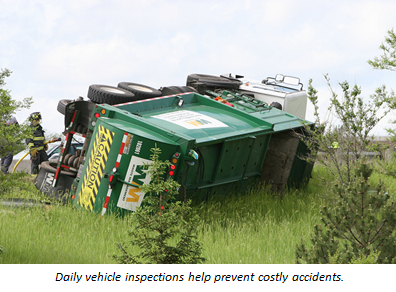The U.S. Federal Motor Carrier Safety Administration (FMCSA) has proposed a rule change to reduce the documentation required for commercial vehicle inspections.
The way it is now, a driver must fill out a Driver Vehicle Inspection Form (DVIR) every time they finish using a vehicle, whether there’s a problem with the vehicle or not. The new rules –which are under review but likely to be approved—would require inspection reports to be completed only if there is a problem.
If the only reason a company does daily vehicle inspections is to be compliant with laws and regulations, then that company’s management is probably pretty happy about the pending change, because compliance will be easier.
 Companies with that attitude have probably already been implicitly advocating pencil-whipped inspections, and now drivers don’t even have to go through the motions. Unless the vehicle has a problem that can’t be ignored, they’re “good to go.”
Companies with that attitude have probably already been implicitly advocating pencil-whipped inspections, and now drivers don’t even have to go through the motions. Unless the vehicle has a problem that can’t be ignored, they’re “good to go.”
But if you understand the links between vehicle inspections and safety and between safety and profitability, the new rules won’t have much effect on your operations. Enlightened management teams will continue to require daily documentation of vehicle inspections because they know inspections save money—and that daily documentation is essential in creating a culture where inspections are taken seriously.
Daily documentation holds drivers accountable and makes it clear that the company truly cares about doing inspections the right way—particularly if drivers realize there’s no legal imperative to explain why the company insists on daily inspections.
How Daily Inspections Increase Profitability
When thorough inspections are done every day, you know the vehicles are safe when they leave the yard or garage. That keeps your drivers safe—and that alone should be justification for documented daily vehicle inspections. But there’s also a profit motivation.
Ensuring that your drivers properly inspect vehicles every day helps prevent on-the-job injuries (to employees and others) due to vehicle failures on the road. Such injuries lead to a host of costs, including:
- Increased workers compensation insurance premiums.
- Increased group medical coverage premiums.
- Decreased productivity due to lost work time or less-skilled replacement employees.
- Recruiting and training of replacement employees.
- Legal expense.
Daily documentation, with an equipment inspection checklist such as The Checker, ensures that inspections are done properly, which means it’s far less likely that minor problems will be overlooked before they escalate and cause higher maintenance costs.
There’s also a psychological factor at play—when drivers have to fill out a vehicle inspection checklist every day, they begin to develop a “sense of ownership” for that vehicle—and human nature is to take better care of things you “own.” When drivers are paying attention to the condition of the vehicles they drive every day, they’ll tend not to “beat them up” so bad, resulting in less maintenance.
Daily vehicle inspection data is also useful to management in planning vehicle use, determining maintenance schedules, and evaluating the quality of vehicles. With inspection management software such as The Checker offers, inspection results can easily be aggregated and analyzed to provide management with valuable information for making productivity-enhancing decisions.
Conclusion
The FMCSA’s proposed new rules will have little impact on companies that understand that inspections are smart business. They will carry on as they have been, because they realize they’re protecting employees—and reducing costs— by fostering a company-wide commitment to doing thorough, daily inspections.
To learn more about the FMCSA’s proposal and its significance, please download our free whitepaper, “Does Less Inspection Paperwork Mean Less Inspecting: DVIR Compliance Rules and Your Business.”
Image courtesy of Defense Logistics Agency, Creative Commons.











